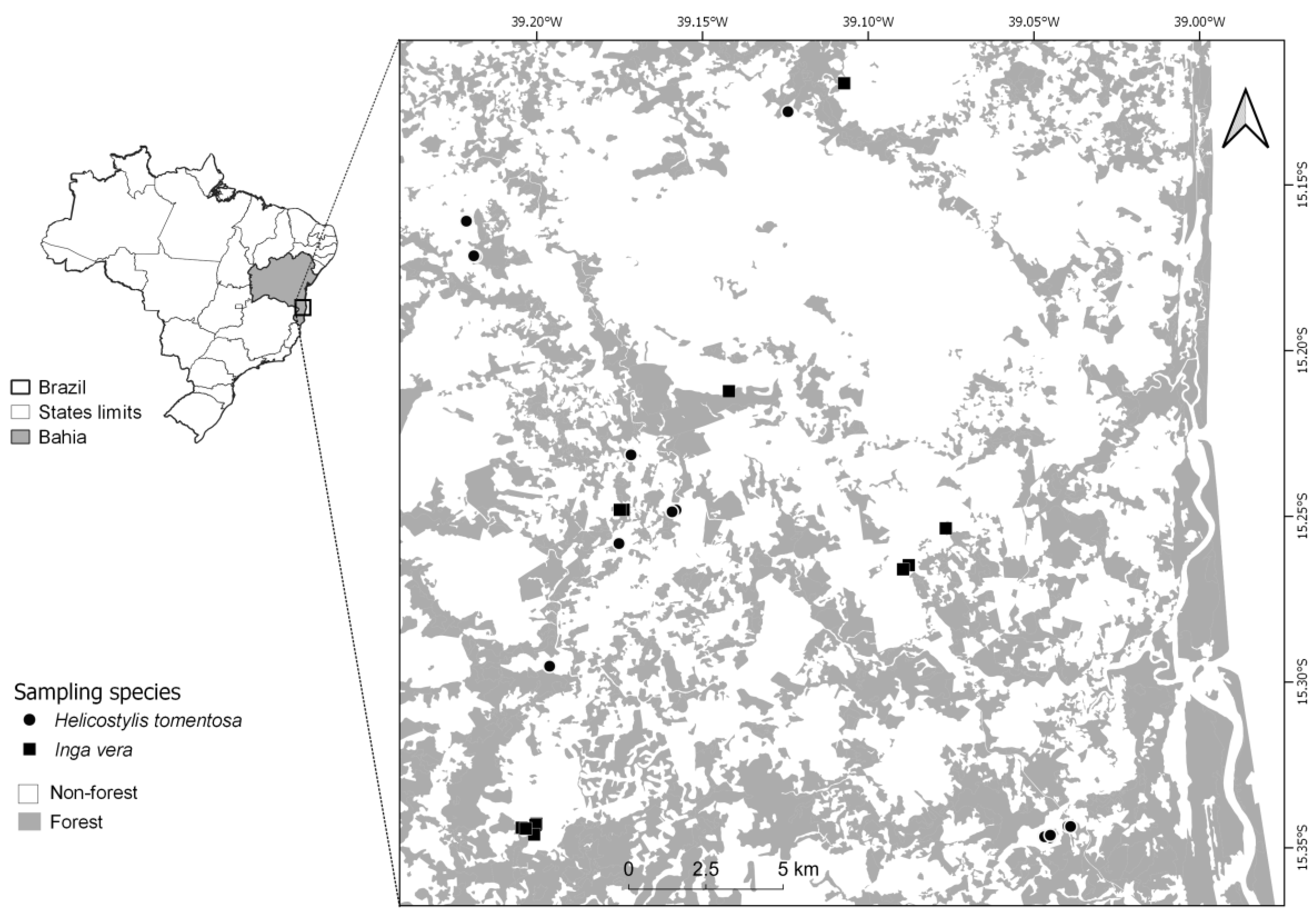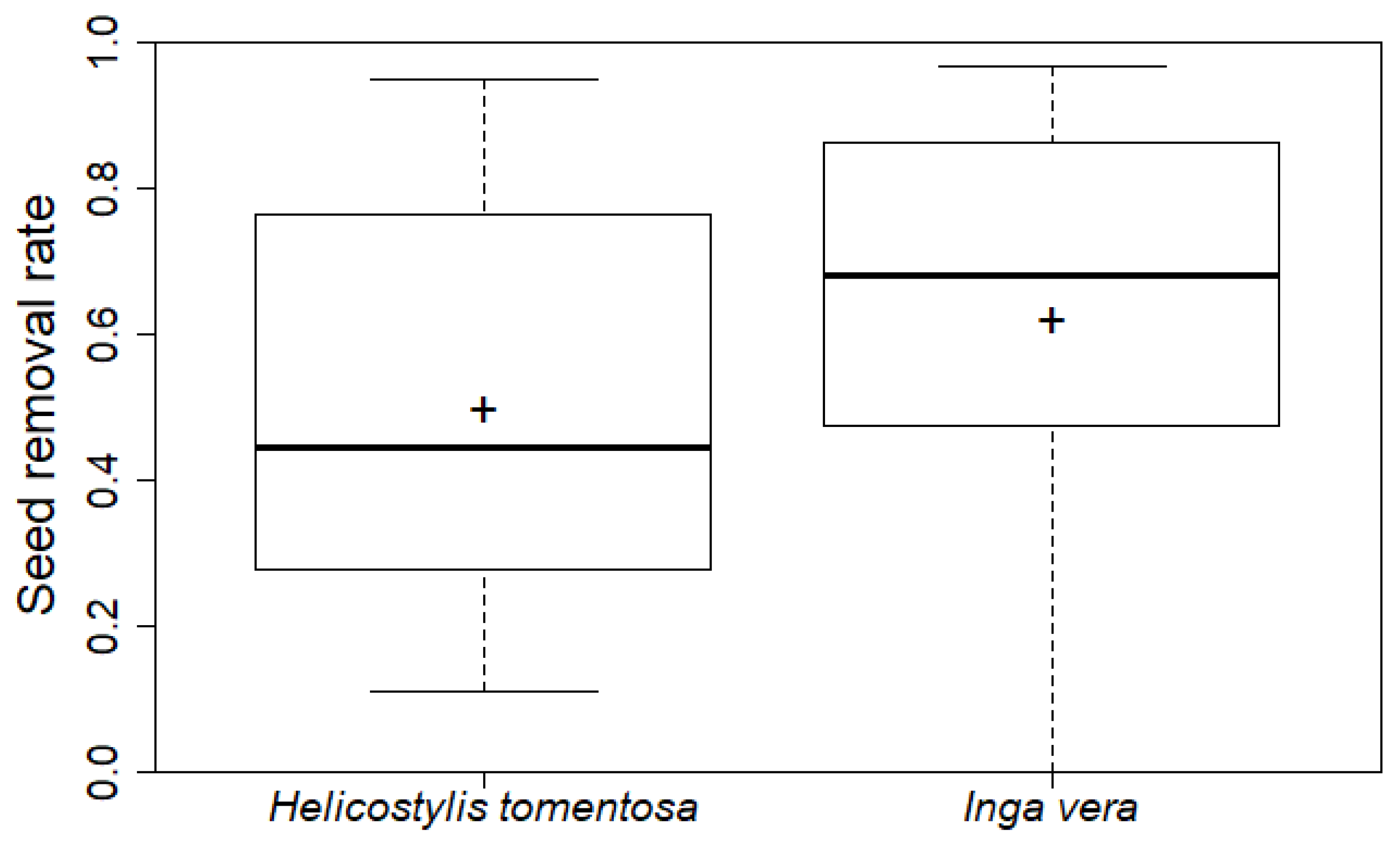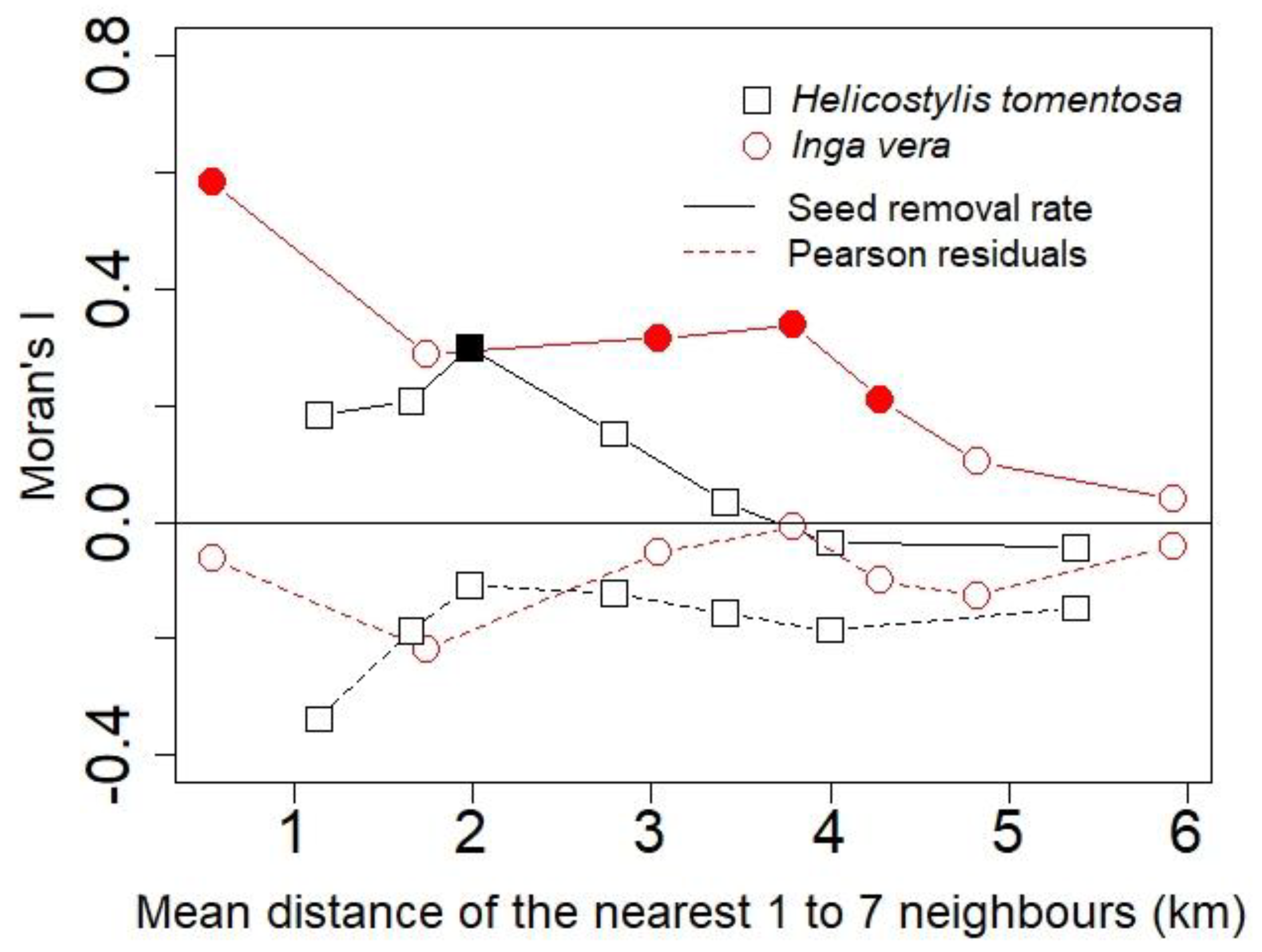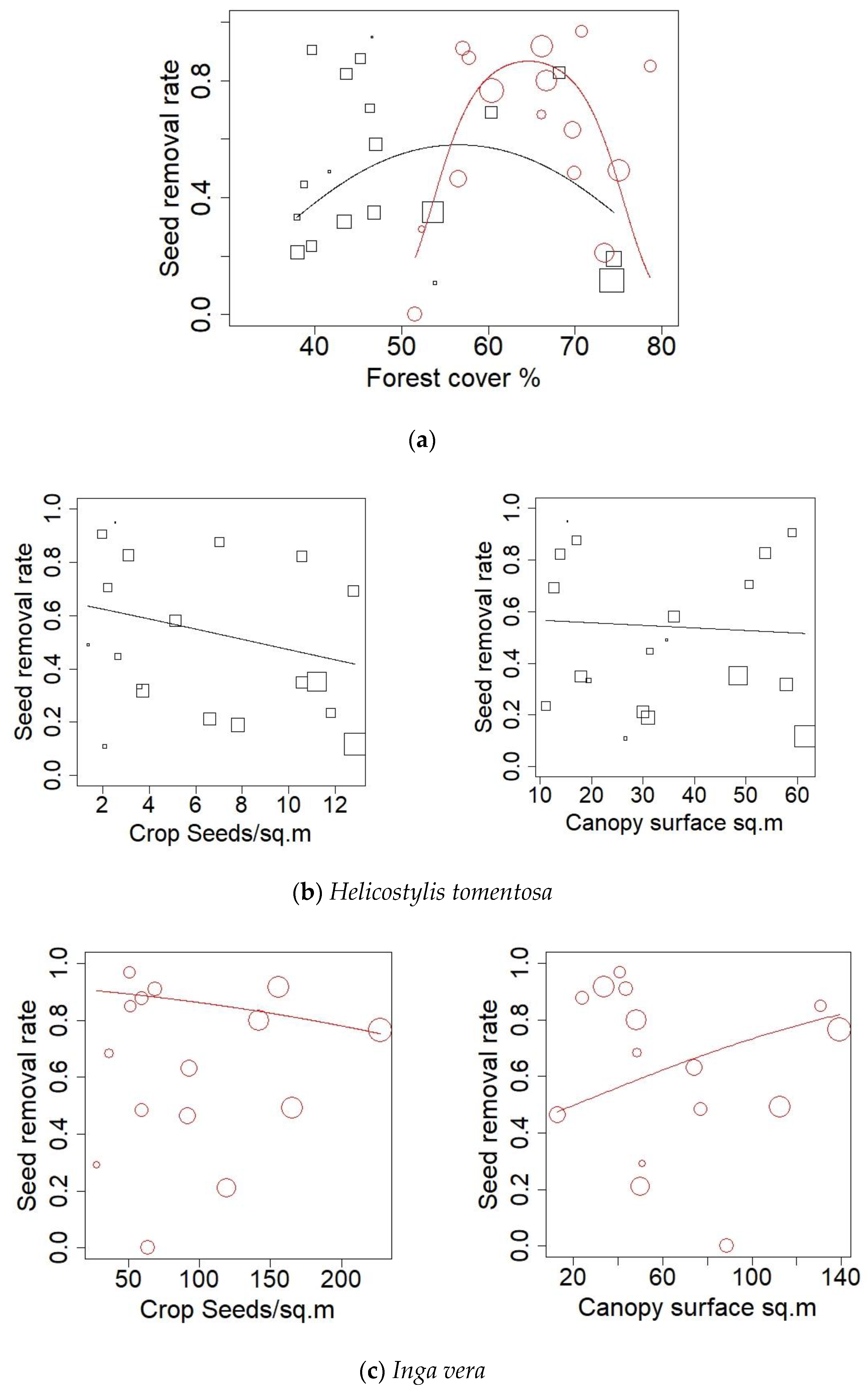Seed Removal Rates in Forest Remnants Respond to Forest Loss at the Landscape Scale
Abstract
:1. Introduction
2. Material and Methods
2.1. Study Area
2.2. Sites and Forest Cover
2.3. Study Species
2.4. Seed Removal Rates
2.5. Statistical Analysis
3. Results
4. Discussion
5. Conclusions
Supplementary Materials
Author Contributions
Funding
Acknowledgments
Conflicts of Interest
References
- Malhi, Y.; Gardner, T.A.; Goldsmith, G.R.; Silman, M.R.; Zelazowski, P. Tropical forests in the anthropocene. Annu. Rev. Environ. Resour. 2014, 39, 125–159. [Google Scholar] [CrossRef] [Green Version]
- Curtis, P.G.; Slay, C.M.; Harris, N.L.; Tyukavina, A.; Hansen, M.C. Classifying drivers of global forest loss. Science 2018, 361, 1108–1111. [Google Scholar] [CrossRef] [PubMed]
- Fahrig, L. Effects of habitat fragmentation on biodiversity. Annu. Rev. Ecol. Evol. Syst. 2003, 34, 487–515. [Google Scholar] [CrossRef] [Green Version]
- Betts, M.G.; Wolf, C.; Ripple, W.J.; Phalan, B.; Millers, K.A.; Duarte, A.; Butchart, S.H.M.; Levi, T. Global forest loss disproportionately erodes biodiversity in intact landscapes. Nature 2017, 547, 441–444. [Google Scholar] [CrossRef] [PubMed]
- Boissier, O.; Bouiges, A.; Mendoza, I.; Feer, F.; Forget, P.-M. Rapid assessment of seed removal and frugivore activity as a tool for monitoring the health status of tropical forests. Biotropica 2014, 46, 633–641. [Google Scholar] [CrossRef]
- Lawton, J.H.; Naeem, S.; Thompson, L.J.; Hector, A.; Crawley, M.J.; Thompson, K.; Hodgson, J.G. Biodiversity and ecosystem function: Getting the Ecotron experiment in its correct context. Funct. Ecol. 1998, 12, 848–853. [Google Scholar]
- Bibby, C.J.; Burgess, N.D.; Hill, D.A.; Mustoe, S. Bird Census Techniques, 2nd ed.; Academic Press: Amsterdam, The Netherlands, 2000. [Google Scholar]
- Gardner, T.A.; Barlow, J.; Araujo, I.S.; Ávila-Pires, T.C.; Bonaldo, A.B.; Costa, J.E.; Esposito, M.C.; Ferreira, L.V.; Hawes, J.; Hernandez, M.I.M.; et al. The cost-effectiveness of biodiversity surveys in tropical forests. Ecol. Lett. 2008, 11, 139–150. [Google Scholar] [CrossRef] [PubMed]
- Abate, T. Environmental rapid-assessment programs have appeal and critics. Are they the domain of the conservation elite? BioScience 1992, 42, 486–489. [Google Scholar] [CrossRef]
- Parker, T.A., III. On the use of tape recorders in avifaunal surveys. Auk 1991, 108, 443–444. [Google Scholar]
- O’Farrell, M.J.; Gannon, W.L. A comparison of acoustic versus capture techniques for the inventory of bats. J. Mamm. 1999, 80, 24–30. [Google Scholar] [CrossRef]
- Majumder, A.; Qureshi, Q.; Sankar, K.; Kumar, A. Long-term monitoring of a Bengal tiger (Panthera tigris tigris) population in a human-dominated landscape of Central India. Eur. J. Wildl. Res. 2017, 63, 17. [Google Scholar] [CrossRef]
- Messinger, M.; Asner, G.P.; Silman, M. Rapid assessments of amazon forest structure and biomass using small unmanned aerial systems. Remote Sens. 2016, 8, 615. [Google Scholar] [CrossRef] [Green Version]
- Kellner, J.R.; Armston, J.; Birrer, M.; Cushman, K.C.; Duncanson, L.; Eck, C.; Falleger, C.; Imbach, B.; Král, K.; Krůček, M.; et al. New opportunities for forest remote sensing through ultra-high-density drone lidar. Surv. Geophys. 2019, 40, 959–977. [Google Scholar] [CrossRef] [Green Version]
- Valiente-Banuet, A.; Aizen, M.A.; Alcántara, J.M.; Arroyo, J.; Cocucci, A.; Galetti, M.; García, M.B.; García, D.; Gómez, J.M.; Jordano, P.; et al. Beyond species loss: The extinction of ecological interactions in a changing world. Funct. Ecol. 2015, 29, 299–307. [Google Scholar] [CrossRef]
- Lermyte, C.; Forget, P.-M. Rapid assessment of dispersal failure and seedling recruitment of large-seeded non- timber forest products trees in a tropical rainforest. Trop. Conserv. Sci. 2009, 2, 404–424. [Google Scholar] [CrossRef] [Green Version]
- Hambuckers, J.; Dauvrin, A.; Trolliet, F.; Evrard, Q.; Forget, P.M.; Hambuckers, A. How can seed removal rates of zoochoric tree species be assessed quickly and accurately? For. Ecol. Manag. 2017, 403, 152–160. [Google Scholar] [CrossRef]
- Boissier, O.; Feer, F.; Henry, P.-Y.; Forget, P.-M. Modifications of the rainforest frugivore community are associated with reduced seed removal at the community level. Ecol. Appl. 2020, 30, e02086. [Google Scholar] [CrossRef] [PubMed]
- Albert, A.; Huynen, M.-C.; Savini, T.; Hambuckers, A. Influence of food resources on the ranging pattern of Northern pigtailed macaques (Macaca leonina). Int. J. Primatol. 2013, 34, 693–713. [Google Scholar] [CrossRef]
- José-Domínguez, J.M.; Huynen, M.C.; García, C.J.; Albert-Daviaud, A.; Savini, T.; Asensio, N. Non-territorial Macaques Can Range Like Territorial Gibbons When Partially Provisioned With Food. Biotropica 2015, 47, 733–744. [Google Scholar] [CrossRef]
- Gazagne, E.; José-Domínguez, J.M.; Huynen, M.C.; Hambuckers, A.; Poncin, P.; Savini, T.; Brotcorne, F. Northern pigtailed macaques rely on old growth plantations to offset low fruit availability in a degraded forest fragment. Am. J. Primatol. 2020, 82, e23117. [Google Scholar] [CrossRef]
- Patil, G.P.; Brooks, R.P.; Myers, W.L.; Rapport, D.J.; Taillie, C. Ecosystem health and its measurement at landscape scale: Toward the next generation of quantitative assessments. Ecosyst. Health 2001, 7, 307–316. [Google Scholar] [CrossRef]
- Mangan, S.A.; Schnitzer, S.A.; Herre, E.A.; Mack, K.M.L.; Valencia, M.C.; Sanchez, E.I.; Bever, J.D. Negative plant-soil feedback predicts tree-species relative abundance in a tropical forest. Nature 2010, 466, 752–755. [Google Scholar] [CrossRef] [PubMed]
- Swamy, V.; Terborgh, J.W. Distance-responsive natural enemies strongly influence seedling establishment patterns of multiple species in an Amazonian rain forest. J. Ecol. 2010, 98, 1096–1107. [Google Scholar] [CrossRef]
- Bagchi, R.; Gallery, R.E.; Gripenberg, S.; Gurr, S.J.; Narayan, L.; Addis, C.E.; Freckleton, R.P.; Lewis, O.T. Pathogens and insect herbivores drive rainforest plant diversity and composition. Nature 2014, 506, 85–88. [Google Scholar] [CrossRef] [PubMed]
- Culot, L.; Lazo, F.J.J.M.; Huynen, M.C.; Poncin, P.; Heymann, E.W. Seasonal variation in seed dispersal by tamarins alters seed rain in a secondary rain forest. Int. J. Primatol. 2010, 31, 553–569. [Google Scholar] [CrossRef] [Green Version]
- Lengyel, S.; Gove, A.D.; Latimer, A.M.; Majer, J.D.; Dunn, R.R. Convergent evolution of seed dispersal by ants, and phylogeny and biogeography in flowering plants: A global survey. Perspect. Plant Ecol. Evol. Syst. 2010, 12, 43–55. [Google Scholar] [CrossRef]
- Aliyu, B.; Adamu, H.; Moltchanova, E.; Forget, P.-M.; Chapman, H. The interplay of habitat and seed type on scatterhoarding behavior in a fragmented afromontane forest landscape. Biotropica 2014, 46, 264–267. [Google Scholar] [CrossRef]
- Keuroghlian, A.; Eaton, D.P. Removal of palm fruits and ecosystem engineering in palm stands by white-lipped peccaries (Tayassu pecari) and other frugivores in an isolated Atlantic Forest fragment. Biodivers. Conserv. 2009, 18, 1733–1750. [Google Scholar] [CrossRef]
- Markl, J.S.; Schleuning, M.; Forget, P.M.; Jordano, P.; Lambert, J.E.; Traveset, A.; Wright, S.J.; Böhning-Gaese, K. Meta-analysis of the effects of human disturbance on seed dispersal by animals. Conserv. Biol. 2012, 26, 1072–1081. [Google Scholar] [CrossRef] [Green Version]
- Chen, Q.; Tomlinson, K.W.; Cao, L.; Wang, B. Effects of fragmentation on the seed predation and dispersal by rodents differ among species with different seed size. Integr. Zool. 2017, 12, 468–476. [Google Scholar] [CrossRef]
- Wright, S.J.; Duber, H.C. Poachers and forest fragmentation alter seed dispersal, seed survival, and seedling recruitment in the palm Attalea butyraceae, with implications for tropical tree diversity. Biotropica 2001, 33, 583–595. [Google Scholar] [CrossRef]
- Herrerías-Diego, Y.; Quesada, M.; Stoner, K.E.; Lobo, J.A.; Hernández-Flores, Y.; Sanchez Montoya, G. Effect of forest fragmentation on fruit and seed predation of the tropical dry forest tree Ceiba aesculifolia. Biol. Conserv. 2008, 141, 241–248. [Google Scholar] [CrossRef]
- Pessoa, M.; Hambuckers, A.; Benchimol, M.; Rocha-Santos, L.; Bomfim, J.A.; Faria, D.; Cazetta, E. Deforestation drives functional diversity and fruit quality changes in a tropical tree assemblage. Perspect. Plant Ecol. Evol. Syst. 2017, 28, 78–86. [Google Scholar] [CrossRef]
- Prado, P.I.; Pinto, L.P.; Moura, R.T.; Carvalho, A.M.; Thomas, W.W.; Amorin, A.M.; Aguiar, C. Caracterizção dos registros de ocorrência de espécies de plantas e mamíferos no sul da Bahia, Brasil. In Corredor de biodiversidade da Mata Atlântica do sul da Bahia; Instituto de Estudos Sócio-Ambientais do Sul da Bahia e Conservation International do Brasil: Ilhéus, Bahia, Brazil, 2003; pp. 1–16. [Google Scholar]
- Martini, A.M.Z.; Fiaschi, P.; Amorim, A.M.; Paixão, J.L.D. A hot-point within a hot-spot: A high diversity site in Brazil’s Atlantic Forest. Biodivers. Conserv. 2007, 16, 3111–3128. [Google Scholar] [CrossRef]
- Canale, G.R.; Peres, C.A.; Guidorizzi, C.E.; Gatto, C.A.F.; Kierulff, M.C.M. Pervasive defaunation of forest remnants in a tropical biodiversity hotspot. PLoS ONE 2012, 7, e41671. [Google Scholar] [CrossRef] [Green Version]
- Cassano, C.R.; Barlow, J.; Pardini, R. Large mammals in an agroforestry mosaic in the Brazilian Atlantic Forest. Biotropica 2012, 44, 818–825. [Google Scholar] [CrossRef]
- Flesher, K.M.; Laufer, J. Protecting wildlife in a heavily hunted biodiversity hotspot: A case study from the Atlantic Forest of Bahia, Brazil. Trop. Conserv. Sci. 2013, 6, 181–200. [Google Scholar] [CrossRef]
- Beca, G.; Vancine, M.H.; Carvalho, C.S.; Pedrosa, F.; Alves, R.S.C.; Buscariol, D.; Peres, C.A.; Ribeiro, M.C.; Galetti, M. High mammal species turnover in forest patches immersed in biofuel plantations. Biol. Conserv. 2017, 210, 352–359. [Google Scholar] [CrossRef] [Green Version]
- Rocha-Santos, L.; Benchimol, M.; Mayfield, M.M.; Faria, D.; Pessoa, M.S.; Talora, D.C.; Mariano-Neto, E.; Cazetta, E. Functional decay in tree community within tropical fragmented landscapes: Effects of landscape-scale forest cover. PLoS ONE 2017, 12, e0175545. [Google Scholar] [CrossRef] [Green Version]
- Decaëns, T.; Martins, M.B.; Feijoo, A.; Oszwald, J.; Dolédec, S.; Mathieu, J.; Arnaud de Sartre, X.; Bonilla, D.; Brown, G.G.; Cuellar Criollo, Y.A.; et al. Biodiversity loss along a gradient of deforestation in Amazonian agricultural landscapes. Conserv. Biol. 2018, 32, 1380–1391. [Google Scholar] [CrossRef] [PubMed] [Green Version]
- Macedo-Reis, L.E.; Quesada, M.; de Siqueira Neves, F. Forest cover drives insect guild diversity at different landscape scales in tropical dry forests. For. Ecol. Manag. 2019, 443, 36–42. [Google Scholar] [CrossRef]
- McGarigal, K.; Cushman, S.A. Comparative evaluation of experimental approaches to the study of habitat fragmentation effects. Ecol. Appl. 2002, 12, 335–345. [Google Scholar] [CrossRef]
- Rocha-Santos, L.; Pessoa, M.S.; Cassano, C.R.; Talora, D.C.; Orihuela, R.L.L.; Mariano-Neto, E.; Morante-Filho, J.C.; Faria, D.; Cazetta, E. The shrinkage of a forest: Landscape-scale deforestation leading to overall changes in local forest structure. Biol. Conserv. 2016, 196, 1–9. [Google Scholar] [CrossRef]
- Pessoa, M.; Rocca, L.; Talora, D.; Faria, D.; Mariano-Neto, E.; Hambuckers, A.; Cazetta, E. Fruit biomass availability along a forest cover gradiant. Biotropica 2016, 49, 45–55. [Google Scholar] [CrossRef]
- Rocha-Santos, L.; Talora, D.C. Recovery of atlantic rainforest areas altered by distinct land-use histories in northeastern Brazil. Trop. Conserv. Sci. 2012, 5, 475–494. [Google Scholar] [CrossRef] [Green Version]
- Arruda, Y.M.B.C.; Ferraz, I.D.K. Inharé-da-folha-peluda Helicostylis tomenosa (Poep. & Endl.) Rusby. In Informativo Técnico. Rede de Sementes da @mazônia; Ferraz, I.D.K., Sidney, A.N., Ferreira, S.A.N., Camargo, J.L.C., Eds.; INPA: Manaus, Brazil, 2008; pp. 1–2. [Google Scholar]
- de Souza Pessoa, M.; de Vleeschouwer, K.; Amorim, A.M.; Custódio Talora, D. Calendário Fenológico. Uma Ferramenta Para Auxiliar No Cultivo de Espécies Arbóreas Nativitas da Floresta Atläntica no Sul da Bahia; Edus-Editoria da UESC: Ilheus, Brazil, 2011. [Google Scholar]
- Izawa, K. Foods and feeding behavior of wild black-capped capuchin (Cebus apella). Primates 1979, 20, 57–76. [Google Scholar] [CrossRef]
- Catenacci, L.S.; De Vleeschouwer, K.M.; Nogueira-Filho, S.L.G. Seed dispersal by Golden-headed Lion Tamarins Leontopithecus chrysomelas in southern Bahian Atlantic Forest, Brazil. Biotropica 2009, 41, 744–750. [Google Scholar] [CrossRef]
- Stevenson, P.R.; Link, A.; González-Caro, S.; Torres-Jiménez, M.F. Frugivory in canopy plants in a western Amazonian forest: Dispersal systems, phylogenetic ensembles and keystone plants. PLoS ONE 2015, 10, e0140751. [Google Scholar] [CrossRef] [Green Version]
- Bello, C.; Galetti, M.; Montan, D.; Pizo, M.A.; Mariguela, T.C.; Culot, L.; Bufalo, F.; Labecca, F.; Pedrosa, F.; Constantini, R.; et al. Atlantic frugivory: A plant–frugivore interaction data set for the Atlantic Forest. Ecology 2017, 98, 1729. [Google Scholar] [CrossRef] [Green Version]
- Jerozolimski, A.; Ribeiro, M.B.N.; Martins, M. Are tortoises important seed dispersers in Amazonian forests? Oecologia 2009, 161, 517–528. [Google Scholar] [CrossRef]
- Salas, L.A.; Fuller, T.K. Diet of the lowland tapir (Tapirus terrestris L.) in the Tabaro River valley, southern Venezuela. Can. J. Zool. 1996, 74, 1444–1451. [Google Scholar] [CrossRef]
- Prado, H.M. Feeding ecology of five Neotropical ungulates: A critical review. Oecologia Aust. 2013, 17, 459–473. [Google Scholar] [CrossRef] [Green Version]
- Gayot, M.; Henry, O.; Dubost, G.; Sabatier, D. Comparative diet of the two forest cervids of the genus Mazama in French Guiana. J. Trop. Ecol. 2004, 20, 31–43. [Google Scholar] [CrossRef]
- Wiesbauer, M.B.; Giehl, E.L.H.; Jarenkow, J.A. Padrões morfológicos de diásporos de árvores e arvoretas zoocóricas no Parque Estadual de Itapuã, RS, Brasil. Acta Bot. Brasilica 2008, 22, 425–435. [Google Scholar] [CrossRef]
- Orwa, C.; Mutua, A.; Kindt, R.; Jamnadass, R.; Simons, A. Agroforestree Database: A Tree Reference and Selection Guide Version 4.0; World Agroforestry Centre: Nairobi, Kenya, 2009. [Google Scholar]
- Colmanetti, M.A.A.; Barbosa, L.M.; Shirasuna, R.T.; Couto, H.T.Z.D. Phytosociology and structural characterization of woody regeneration from a reforestation with native species of Southeastern Brazil. Rev. Árvore 2016, 40, 209–218. [Google Scholar] [CrossRef] [Green Version]
- Ragusa-Netto, J.; Fecchio, A. Plant food resources and the diet of a parrot community in a gallery forest of the Southern Pantanal (Brazil). Braz. J. Biol. 2006, 66, 1021–1032. [Google Scholar] [CrossRef] [PubMed] [Green Version]
- Carlo, T.A.; Collazo, J.A.; Groom, M.J. Influences of fruit diversity and abundance on bird use of two shaded coffee plantations. Biotropica 2004, 36, 602–614. [Google Scholar] [CrossRef]
- Bevilacqua Marcuzzo, S.; Viera, M. Ecological restoration in Conservation units. In Biodiversity in Ecosystems-Linking Structure and Function; Lo, Y.-H., Blanco, J.A., Roy, S., Eds.; IntechOpen Limited: London, UK, 2015; pp. 493–509. [Google Scholar]
- Galetti, M.; Keuroghlian, A.; Hanada, L.; Morato, M.I. Frugivory and seed dispersal by the lowland tapir (Tapirus terrestris) in Southeast Brazil. Biotropica 2001, 33, 723–726. [Google Scholar] [CrossRef]
- Beck, H. Seed predation and dispersal by peccaries throughout the Neotropics and its consequences: A review and synthesis. In Seed Fate: Predation, Dispersal and Seedling Establishment; Forget, P.M., Hulme, P., Lambert, J.E., Vander Wall, S.B., Eds.; CABI Publishing: Wallinford, UK, 2004; pp. 77–115. [Google Scholar]
- Rondeux, J. La Mesure des Arbres et des Peuplements Forestiers; Presses Agronomiques de Gembloux: Gembloux, Belgium, 1993. [Google Scholar]
- Kalogirou, S. Package ‘lctools’. Local Correlation, Spatial Inequalities and Other Tools. Available online: https://CRAN.R-project.org/package=lctools (accessed on 15 September 2020).
- Bivand, R.; Altman, M.; Anselin, L.; Assunção, R.; Berke, O.; Bernat, A.; Blanchet, G. Package ‘spdep’. Available online: https://github.com/r-spatial/spdep/ (accessed on 15 September 2020).
- Dormann, C.F.; McPherson, J.M.; Araújo, M.B.; Bivand, R.; Bolliger, J.; Carl, G.; Davies, R.G.; Hirzel, A.; Jetz, W.; Kissling, W.D.; et al. Methods to account for spatial autocorrelation in the analysis of species distributional data: A review. Ecography 2007, 30, 609–628. [Google Scholar] [CrossRef] [Green Version]
- McLeod, A.I.; Xu, C. Best subset GLM and regression utilities. Available online: https://CRAN.R-project.org/package=bestglm (accessed on 16 June 2020).
- Zhang, D. R-squared and related measures. Available online: https://CRAN.R-project.org/package=rsq (accessed on 19 October 2020).
- Boyle, S.A.; Smith, A.T. Can landscape and species characteristics predict primate presence in forest fragments in the Brazilian Amazon? Biol. Conserv. 2010, 143, 1134–1143. [Google Scholar] [CrossRef]
- Raboy, B.E.; Christman, M.C.; Dietz, J.M. The use of degraded and shade cocoa forests by Endangered golden-headed lion tamarins Leontopithecus chrysomelas. Oryx 2004, 38, 75–83. [Google Scholar] [CrossRef] [Green Version]
- Tisovec, K.C.; Cassano, C.R.; Boubli, J.P.; Pardini, R. Mixed-species groups of marmosets and tamarins across a gradient of agroforestry intensification. Biotropica 2014, 46, 248–255. [Google Scholar] [CrossRef]
- De Vleeschouwer, K.M.; Oliveira, L.C. Report on the presence of a group of golden-headed lion tamarins (Leontopithecus chrysomelas), an endangered primate species in a rubber plantation in southern Bahia, Brazil. Primate Biol. 2017, 4, 61–67. [Google Scholar] [CrossRef] [Green Version]
- Galetti, M.; Donatti, C.I.; Pires, A.S.; Guimarães Jr, P.R.; Jordano, P. Seed survival and dispersal of an endemic Atlantic forest palm: The combined effects of defaunation and forest fragmentation. Bot. J. Linn. Soc. 2006, 151, 141–149. [Google Scholar] [CrossRef] [Green Version]
- Soares, L.A.S.S.; Faria, D.; Vélez-Garcia, F.; Vieira, E.M.; Talora, D.C.; Cazetta, E. Implications of habitat loss on seed predation and early recruitment of a keystone palm in anthropogenic landscapes in the Brazilian Atlantic rainforest. PLoS ONE 2015, 10, e0133540. [Google Scholar] [CrossRef] [Green Version]
- Pérez-Méndez, N.; Jordano, P.; García, C.; Valido, A. The signatures of Anthropocene defaunation: Cascading effects of the seed dispersal collapse. Sci. Rep. 2016, 6, 24820. [Google Scholar] [CrossRef] [PubMed] [Green Version]
- Barcellos de Souza, J.B.; Nóbrega Alves, R.R. Hunting and wildlife use in an Atlantic Forest remnant of northeastern Brazil. Trop. Conserv. Sci. 2014, 7, 145–160. [Google Scholar] [CrossRef] [Green Version]
- Ordano, M.; Blendinger, P.G.; Lomáscolo, S.B.; Chacoff, N.P.; Sánchez, M.S.; Núñez Montellano, M.G.; Jiménez, J.; Ruggera, R.A.; Valoy, M. The role of trait combination in the conspicuousness of fruit display among bird-dispersed plants. Funct. Ecol. 2017, 31, 1718–1727. [Google Scholar] [CrossRef]
- Palacio, F.X.; Ordano, M. The strength and drivers of bird-mediated selection on fruit crop size: A meta-analysis. Front. Ecol. Evol. 2018, 6, 18. [Google Scholar] [CrossRef] [Green Version]
- Briani, D.C.; Guimarães, P.R., Jr. Seed predation and fruit damage of Solanum lycocarpum (Solanaceae) by rodents in the cerrado of central Brazil. Acta. Oecol. 2007, 31, 8–12. [Google Scholar] [CrossRef]
- Trolliet, F.; Forget, P.-M.; Huynen, M.-C.; Hambuckers, A. Forest cover, hunting pressure, and fruit availability influence seed dispersal in a forest-savanna mosaic in the Congo Basin. Biotropica 2017, 49, 337–345. [Google Scholar] [CrossRef]




| Coefficients | Estimates | Standard Errors | Z-Values | p-Values |
|---|---|---|---|---|
| Intercept | −9.76 | 1.041 | −9.374 | <0.0001 |
| Forest cover (1600 m radius) | 0.333 | 0.041 | 8.207 | <0.0001 |
| Forest cover2 | −0.0029 | 0.0003 | −8.453 | <0.0001 |
| Canopy surface | 0.035 | 0.0060 | 5.904 | <0.0001 |
| Crop size | 0.130 | 0.0307 | 4.227 | <0.0001 |
| Crop x Canopy surface | −0.006 | 0.0006 | −9.824 | <0.0001 |
| Scaled auto-covariate | −0.210 | 0.0569 | −3.760 | 0.0002 |
| Coefficients | Estimates | Standard Errors | Z-Values | p-Values |
|---|---|---|---|---|
| Intercept | −79.38 | 5.799 | −13.69 | <0.0001 |
| Forest cover (1400 m radius) | 2.493 | 0.1820 | 13.69 | <0.0001 |
| Forest cover2 | −0.0193 | 0.0014 | −13.64 | <0.0001 |
| Canopy surface | 0.0195 | 0.0037 | 5.329 | <0.0001 |
| Crop size | −0.0009 | 0.0021 | −0.466 | 0.6415 |
| Crop x Canopy surface | −0.00007 | 0.00002 | −3.483 | 0.0005 |
| Scaled auto-covariate | −0.1873 | 0.0635 | −2.823 | 0.0048 |
Publisher’s Note: MDPI stays neutral with regard to jurisdictional claims in published maps and institutional affiliations. |
© 2020 by the authors. Licensee MDPI, Basel, Switzerland. This article is an open access article distributed under the terms and conditions of the Creative Commons Attribution (CC BY) license (http://creativecommons.org/licenses/by/4.0/).
Share and Cite
Hambuckers, A.; Trolliet, F.; Simon, A.; Cazetta, E.; Rocha-Santos, L. Seed Removal Rates in Forest Remnants Respond to Forest Loss at the Landscape Scale. Forests 2020, 11, 1144. https://doi.org/10.3390/f11111144
Hambuckers A, Trolliet F, Simon A, Cazetta E, Rocha-Santos L. Seed Removal Rates in Forest Remnants Respond to Forest Loss at the Landscape Scale. Forests. 2020; 11(11):1144. https://doi.org/10.3390/f11111144
Chicago/Turabian StyleHambuckers, Alain, Franck Trolliet, Astrid Simon, Eliana Cazetta, and Larissa Rocha-Santos. 2020. "Seed Removal Rates in Forest Remnants Respond to Forest Loss at the Landscape Scale" Forests 11, no. 11: 1144. https://doi.org/10.3390/f11111144
APA StyleHambuckers, A., Trolliet, F., Simon, A., Cazetta, E., & Rocha-Santos, L. (2020). Seed Removal Rates in Forest Remnants Respond to Forest Loss at the Landscape Scale. Forests, 11(11), 1144. https://doi.org/10.3390/f11111144






